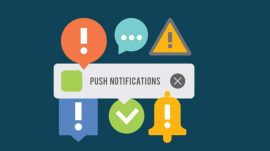How to maximize value from push notifications


In my last post, I talked about how to use email to get even more out of your most valuable users (your customers!). Email is certainly a tried-and-true digital channel, but it’s also limited, especially in the case of app retention and engagement.
In the go-go-go mobile world of 2018, adding any extra steps (e.g., checking email) to a conversion funnel is a deal-breaker. If you have an app, and you’re trying to goose users into action, push notifications are the way to go — yet they’re used less than optimally by many marketers.
In this column, we’ll break down the not-yet-mighty push notification: general best practices, opt-in best practices, two main ways to segment your customers, timing best practices and push notification types.
Let’s get started.
General best practices for push notifications
These may seem obvious to some, but they’re certainly not universally in play. Make sure that at the very least, you’re incorporating these into your push-notification strategy:

Opt-in best practices for push notifications
Before users take any action on your push notifications, they must opt in. However, this often presents a challenge. According to Accengage, only 43 percent of iOS users opt in (Android users are opted in automatically when they install an app). In working with our app clients, we’ve confirmed five truisms that will help improve your opt-in rate.

Segment your push notifications according to behavior
The more tailored to its audience a push notification is, the higher its open rate will be. As such, segmenting is imperative. One effective way to segment your user base is through their behavior. Looking at the various ways customers interact with the app provides valuable insight into what they care about and how engaged they are with the brand. This, in turn, helps us understand how often we want to send them pushes and what aspects of the app to highlight when we do.
Potential customer segments that can be used to understand how engaged certain customers are with the app include disengaged, somewhat engaged and highly engaged. Let’s say you have a user who downloaded your app a couple of weeks ago, browsed once and hasn’t returned. Don’t flood that user with notifications; they’ll be more likely to see them as spam.
On the other hand, if you have a user who browses often and has yet to pull the trigger — especially if there’s a relevant holiday coming — you can increase frequency to remind him/her that there’s an item waiting for them to purchase (e.g., an Amazon user who adds a grill to his/her cart in June might be more open to purchasing as July 4 approaches).
Segment your push notifications according to user preferences
Another effective way to segment users is by their preferences, which informs strategy on which products customers care about the most. We can gain insight into users’ preferences by looking at their past engagement with products through the app and website and by defining their inclusive and exclusive traits.
Inclusive traits. When a user interacts with a product through the website or app, this indicates they have a positive preference towards that item.
Exclusive traits. When a user ignores promotions or emails for a certain product, this indicates they might have a negative preference toward that item.
If a user has clearly defined traits, make sure to use push notifications aligned with their inclusive traits, and scale way back on notifications aligned with their exclusive traits.
Be strategic about your timing for push notifications
The effectiveness of any push-notification strategy is largely dependent on timing. The day of the week, time of day and frequency at which you send push notifications can drastically affect their open rates.
We’ve learned from app campaigns to recommend these four timing insights:
Consider the range of notification types to utilize
There are many different types of push notifications that can be used to accomplish a variety of goals, ranging from informing users of new promotions to providing them with industry-related entertainment. Below are examples of common types of push notifications.
Welcome push

Pizza Hub offers a discount in its welcome push, which effectively conveys to the customer the value of receiving push notifications.
Preference-based push

Gilt updates users when items they are interested in come back in stock. Use inclusive traits and sales data to keep customers in the loop on their favorite products.
Cart abandonment push

TripAdvisor effectively reminds users of the value in their abandoned cart. If the customer ignores this push, too, they could include a discount in the next push.
Delivery update push

GrubHub keeps users informed on when their deliveries will arrive. They use clever wording to make the message exciting and enjoyable to read.
Topical push

iHeartRadio ties Women’s History Month into their push notification to make it feel more organic and justified. The more relevant an event is to the promotion or CTA (call to action), the more effective the topical push will be.
Promotional push

Charlotte Russe uses capitalization to generate excitement in their promotional push. Their push provides a reason for the sale (“Appy Hour”) and conveys all the necessary information a user would need to partake.
Conclusion
Once you’ve gotten users to download your app, push notifications are a great (free) way to increase conversions and revenue — but don’t abuse the privilege. Be thoughtful, be relevant, and be helpful, and your users will reward you by engaging.
The post How to maximize value from push notifications appeared first on Marketing Land.
From our sponsors: How to maximize value from push notifications



